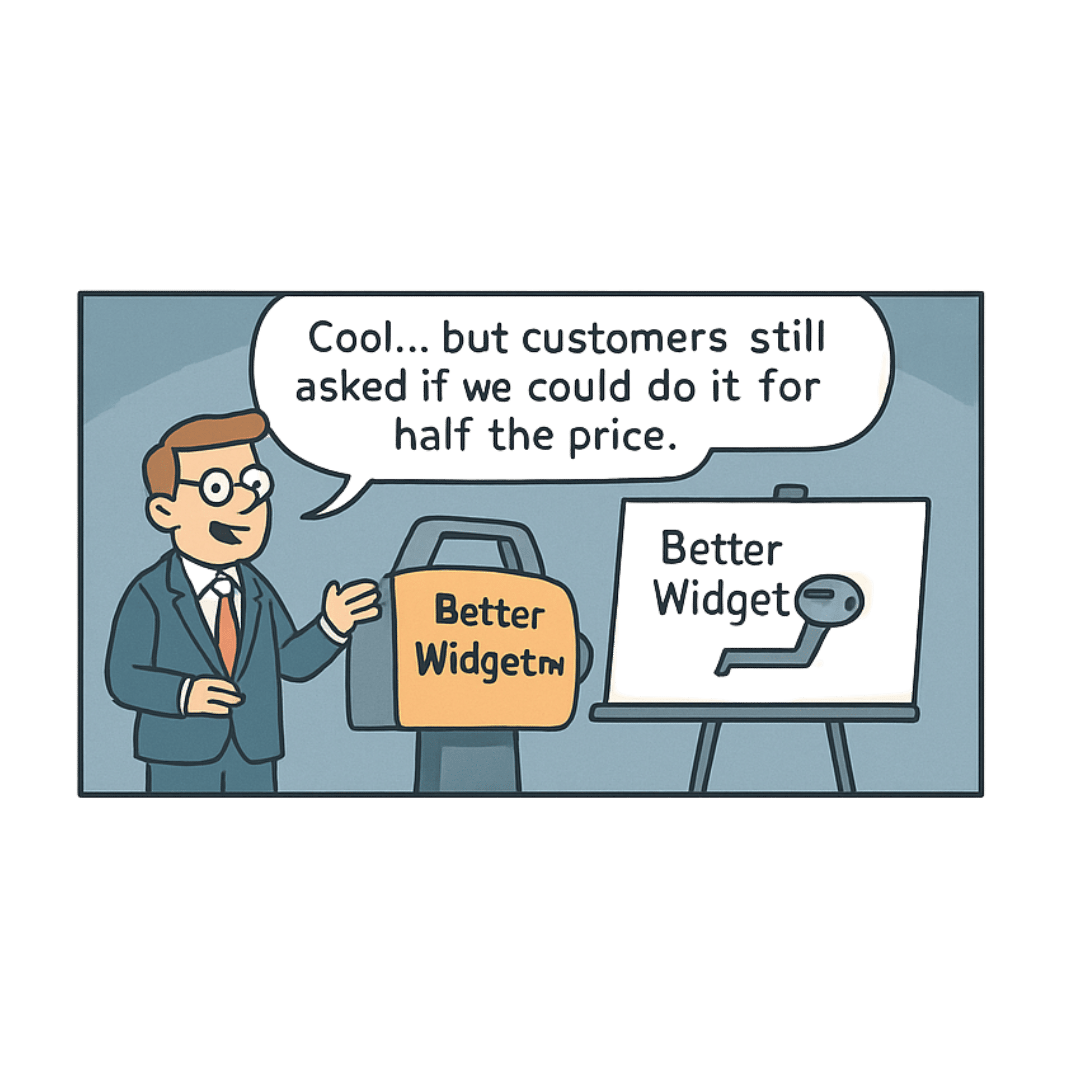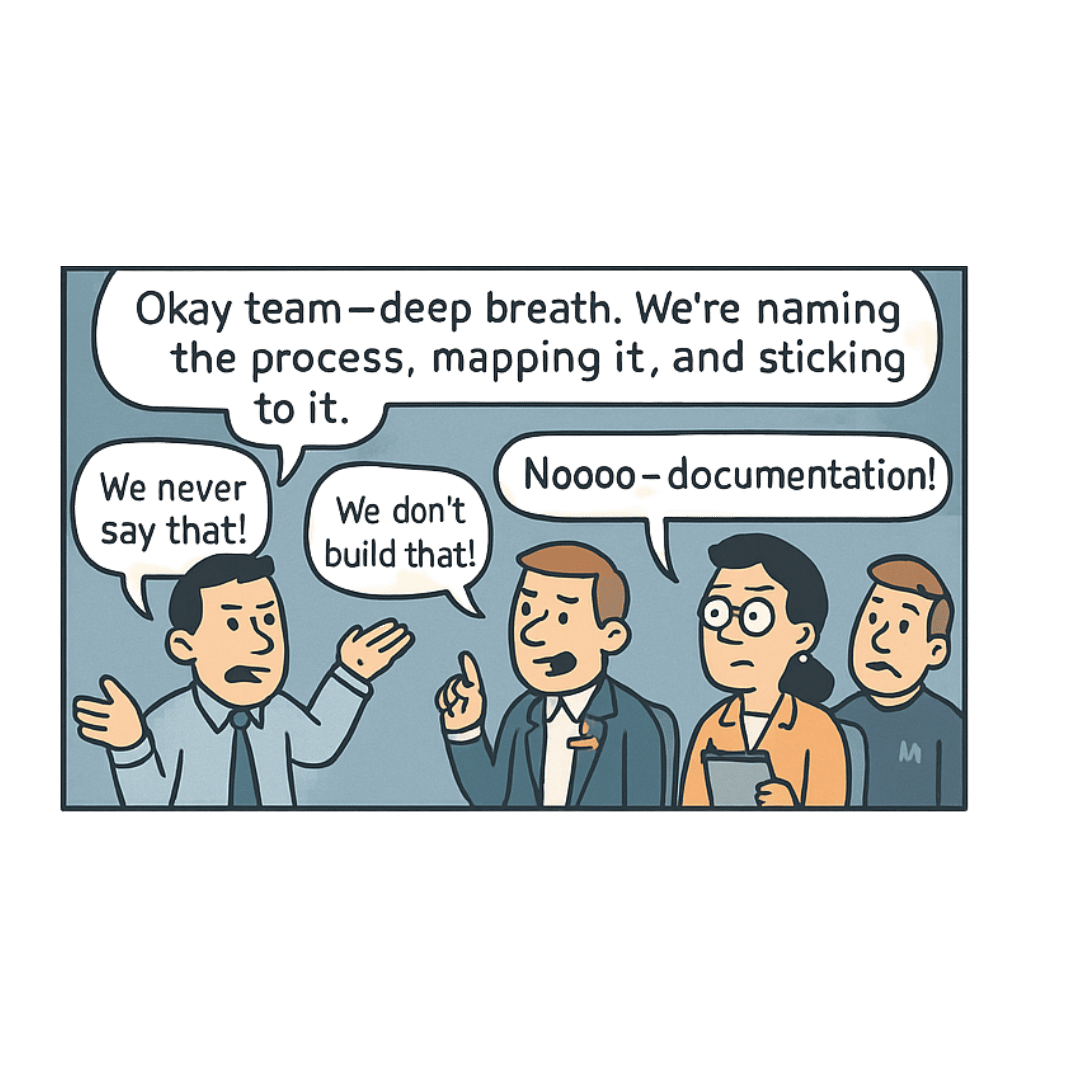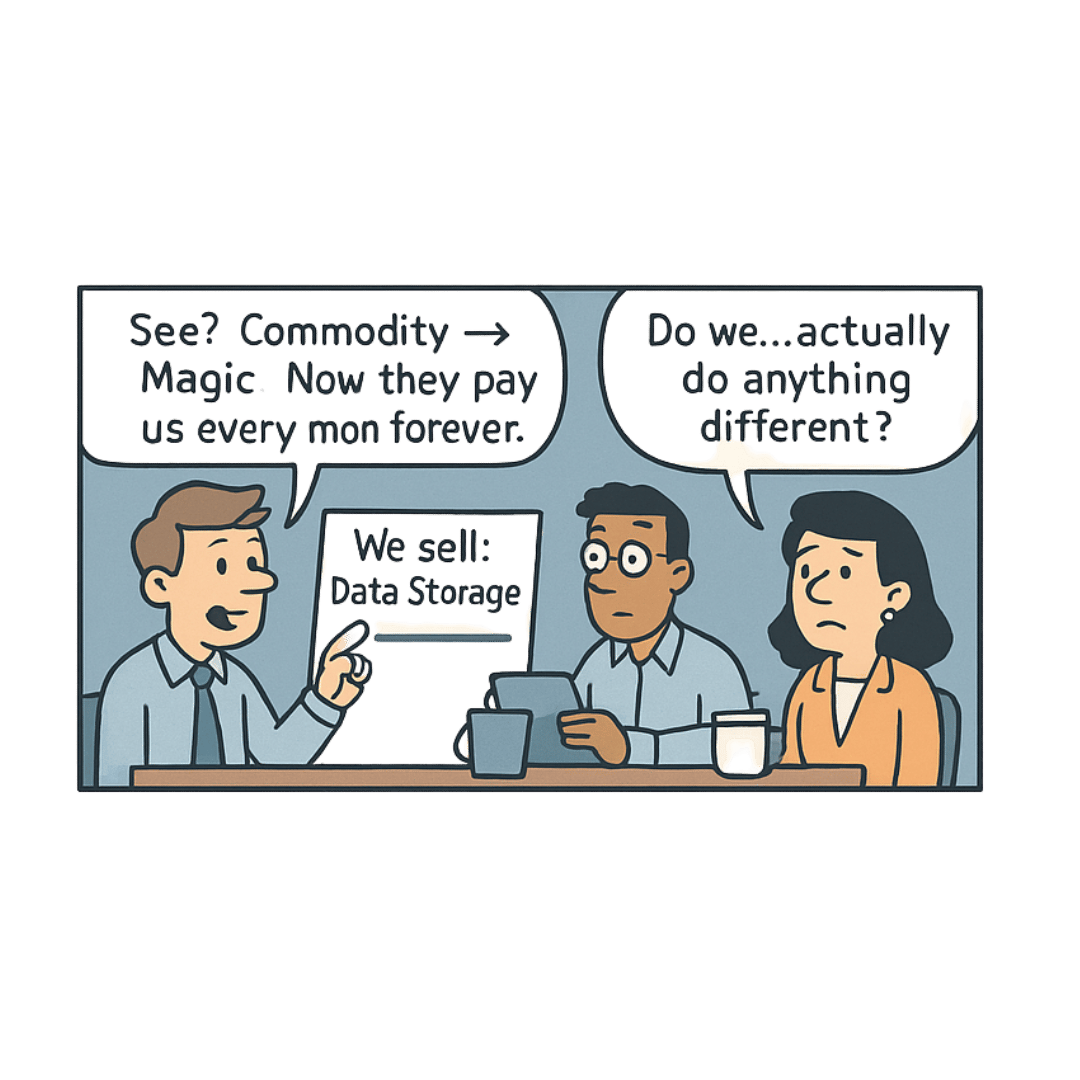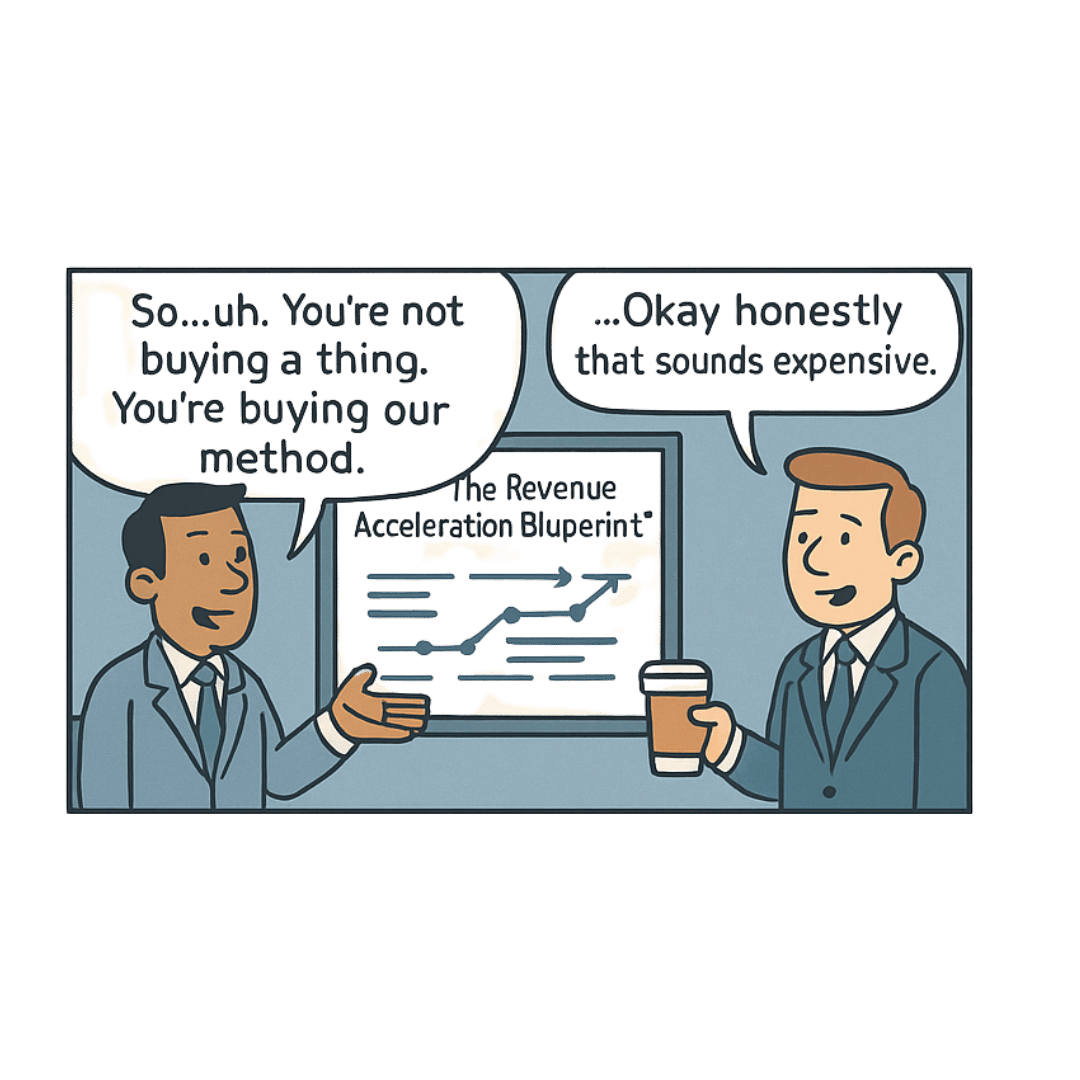- the Weekly Invoice
- Posts
- Your Sales Team is not a Cost Center
Your Sales Team is not a Cost Center
Why Process is the Product—And How Teams Get Stuck in the Commodity Trap
If you want to break free from pricing conversations and actually own your sale, you can’t just build a better widget or a sharper sales deck. You need to create a process—a living, breathing operating model that differentiates your business, gives your team alignment, and shapes the way customers buy from you. Most founders think “product development” just means R&D, but the teams winning in 2025 treat it as a company-wide act of choreography.
Let’s break down—directly, practically, and with some hard-won operator lessons—how to steer those internal conversations, build a playbook, and transform the way you design, price, and go to market. This is not theory. This is what makes the difference between scale and attrition.
A real world example of this productization process is the company Hubspot, which at it’s core is a very commoditized product, data storage. Nothing is unique about it’s primary function. Howevery by focusing their pricing models on use case and features, they give away the commodity and lock you in to application processes. This allows them to control the conversation around database, extending beyond a key selling point into an industry standard.
Modernize your marketing with AdQuick
AdQuick unlocks the benefits of Out Of Home (OOH) advertising in a way no one else has. Approaching the problem with eyes to performance, created for marketers with the engineering excellence you’ve come to expect for the internet.
Marketers agree OOH is one of the best ways for building brand awareness, reaching new customers, and reinforcing your brand message. It’s just been difficult to scale. But with AdQuick, you can easily plan, deploy and measure campaigns just as easily as digital ads, making them a no-brainer to add to your team’s toolbox.
Why Process Is the Product—And How Teams Get Stuck
The default for most B2B businesses: product = SKU, and service = project hours. From CRM vendors to SaaS, nearly everyone starts by pricing the thing. But as soon as your market matures—and it always does—your “thing” becomes replaceable, and the price race to zero begins.
The real advantage? It’s in the proprietary way you deliver, integrate, enable, and optimize that thing. It’s your “customer success operating model,” your onboarding framework, your systems integration, and your analytics automation. That’s where the margin and customer loyalty live.
Hard truth: if you aren’t owning the process, your customers will price-shop the commodity and treat your team as a cost center.
The Playbook for Building (and Selling) Process as Product

Step 1: Make “Process” a First-Class Citizen
Start your internal conversation by explicitly renaming your work. Don’t call it “the product” if the value is really in the workflow, onboarding, or consulting. Invent language that frames your process as the IP—“growth accelerator program,” “predictable acquisition system,” “automated retention suite.”
Here’s why this matters:
The language you use inside affects how every team member talks to (and sells into) the market.
If you treat process as core product, you force cross-departmental groups (sales, product, ops, marketing) to clarify what is unique, repeatable, and high-value about how you deliver.
Teams that do this well never say “just a feature” or “basic support.” Every component is framed as an element of a high-value system.
Operator tip:
Host a kickoff session naming and mapping the end-to-end customer journey, emphasizing what your company does at each step that competitors can’t—or won’t—copy.
Step 2: Build Cross-Department Collaboration Into the DNA
Product isn’t built in a vacuum. The most successful B2B teams bring together a core coalition from Sales, Product, Operations, and Marketing—early and often—to define, co-own, and refine the customer journey.
Why this works:
Sales brings market feedback, pain points, and objections straight from the field, ensuring the process solves real, urgent problems versus imagined ones.
Product translates business challenges into scalable features or automation, defining the boundary between bespoke work and repeatable product.
Operations ensures your process can be standardized, delivered at scale, and tracked for outcomes (not just activity).
Marketing packages and communicates not only what you do, but how you do it, giving your process a clear, differentiated brand story.
This “coalition approach” breaks silos, stops blame-shifting, and creates aligned incentives for scale—e.g., variable compensation not just for closing deals but for onboarding and expansion outcomes.
What does this look like in practice?
A weekly “growth sprint” meeting with senior representatives from each function.
Joint definition of messaging, demo experiences, pricing boundaries, and what is considered “standard delivery” vs. paid customization.

Step 3: Design the Process Like a Product (Not a Project)
Start with the assumption: if it isn’t mapped, named, and repeatable, it’s not productized enough. Use product development playbook techniques:
Map the customer’s jobs-to-be-done at each touchpoint—even before your product arrives and long after go-live.
Define key hurdles (adoption, integration, reporting, renewals), and codify your distinct approach to solving them.
Use prototypes and pilots internally (and occasionally with “lighthouse” customers) to test new processes before rolling them out broadly.
Example: Instead of generic “customer onboarding,” design an “Accelerated Time-To-Value Program” with a named framework, clear timeline, documented milestones, and uniform deliverables. Even though every client is different, the core experience should be consistent.
How to spot a process ripe for productization:
Are sales constantly reinventing the pitch?
Does delivery vary wildly by who runs the project?
Are outcomes poorly tracked or customer satisfaction too variable?
If yes to any, it’s probably time for a playbook refresh.
Step 4: Document Relentlessly—and Use Those Documents to Align
Your process is only as good as your team’s ability to communicate and execute it the same way, every time.
What this means practically:
For each stage in your process, draft a one-page cheat sheet: who does what, in what order, using which tools.
Document customer-facing materials (implementation blueprints, status update templates, success criteria scorecards).
Make the process transparent—internally and externally.
Why does this matter?
Internal alignment: everyone from SDR to CSM can point to the same artifact when a customer asks, “How does this work?”
External confidence: customers pay premiums for simplicity and certainty, not just better features.
Step 5: Train, Roleplay, and Refine—Company-Wide

Internal knowledge isn’t enough; you need muscle memory across sales, delivery, and marketing.
Operator-to-operator advice:
Run quarterly process walkthroughs—every team member roleplays customer questions.
Test for edge cases: “How would we handle an outlier customer?” “What if our competitor offers X?”
Use recent customer feedback to close the loop on process improvements.
Involve customer stories—bring in recent wins or failures as teachable moments in every training session.
The best-run B2B shops treat process training like product launches: with enablement content, FAQs, and feedback cycles.
Step 6: Price the Process, Not Just the Service
Shift your pricing conversation away from “How much is your CRM license?” or “What’s your hourly rate?” Instead, anchor it in the tangible, unique value of your process:
Package the process as a named tier, bundle, or subscription (even if the deliverables, e.g., seats, reports, or dashboards, look familiar).
Use ROI calculators rooted in process outcomes—time saved, risk reduced, revenue unlocked—so the buyer experiences the value well before renewal time.
Offer guarantees or SLAs tied to process milestones, not just software uptime.
Why is this so potent? Because once your customer buys your way of driving change, the competition never gets to bid pure price—they have to overturn the entire program to even compete.
Step 7: Iterate Based on Real Outcomes, Not Just NPS
Here’s where a mature operating model wins:
Track outcomes that reflect business impact, not just satisfaction—think lead conversion rates, speed to value, churn reduction, expansion velocity.
Create a monthly internal council across Sales, Product, Ops and Marketing to revisit: what’s working, where are process handoffs failing, what real customer impact is emerging?
Give every department performance goals tied to evidenced outcomes from the process, not just their local KPIs.

The Human Side—Making the Conversation Stick Internally
Most resistance to “process as product” comes from one of two places: pride of authorship (teams think their way is best), or fear of change (insecure about new metrics or collaboration). Here’s how great leaders get buy-in:
Start by laying out what hasn’t worked—how pricing core features, negotiating line-by-line on service details, or rewriting onboarding for every client saps time, profit, and morale.
Hold honest, all-hands discussions about what makes your team unique: Is it a rapid feedback loop? Deep industry knowledge? Customer community? Relentlessly positive support? Name it together.
Make every function co-author the new process—give Sales say in what’s productized, let Operations challenge complexity, have Marketing stress-test the narrative for clarity.
Celebrate small wins in public—when the new onboarding playbook saves a deal, shout out the responsible team.
Overcommunicate why this matters: it’s not just about revenue, but about building a franchise brand that customers and employees want to join for years.
What “Process as Product” Looks Like In Action
Picture your sales team opening a meeting not by showing features but by saying, “Here’s our proven approach—we call it the ‘Revenue Acceleration Blueprint.’ These are the exact stages, the value at each step, and why clients consistently see outcomes nobody else delivers. Here’s where you get immediate wins, and here’s our implementation guarantee.”
Or your operations team is trained to say, “We run every engagement with our Playbook. That’s why every handoff is crisp, and why your account manager always knows your last milestone, your next outcome, and where we stand on the roadmap.”
Your marketing doesn’t sell “flexible solutions.” Instead, it names a method—your method—with bold claims rooted in process excellence.
Suddenly, your price is higher, but your win rate jumps, and renewals come easy because customers buy certainty, not just capability.
Closing Operator Notes
Owning your sale means owning your process—across every department, every customer, at every moment. The best B2B teams in 2025 treat product and process as two sides of the same coin, but never lose sight that process is what cannot be copied or undercut.
You can begin today:
Name your process.
Map and document every stage.
Align all teams with a common playbook and shared incentives.
Anchor pricing and value on your method, not your SKU.
Make improvement a continuous, collective job.
Every week you avoid this work, the market moves a bit closer to irrelevance. Every day you lean in, you turn your business from commodity to category of one.
That’s how you build a truly defensible growth model—in your process, not just your product.
Until next week - Grady

